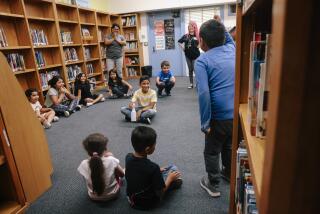REGIONAL REPORT : Job Dreams Fly High at Aviation Camp
- Share via
For 16-year-old Ayinde Mitchell, the dream of flying started when he was a toddler. “I’ve always had an infatuation with how planes fly,” said Mitchell, an honor student at Westchester High.
As he got older, Mitchell’s dreams became more ambitious and his goals turned toward business and government.
But he never lost interest in aviation, and after spending a week at the Aviation Careers Education camp flying Boeing 727 simulators, learning the history of African Americans in aviation and landing a single-engine Cessna at Santa Monica Airport, Mitchell made a career decision.
“I want to be a CEO, a politician and I like aviation--so I came up with airport manager,” Mitchell said.
That is what the organizers and backers of the ACE camp, which is based at the Museum of Flying at Santa Monica Airport, like to hear.
The weeklong program run by the Federal Aviation Administration is aimed at encouraging minority students to find jobs in aviation, from airline pilots and mechanics to airport managers and astronauts.
“There just isn’t the youth excitement about planes today,” said James Whitehead, an FAA safety manager and retired Air Force general who helped start the ACE program in Los Angeles. Flying today is taken for granted, he said, and the ACE program is designed to change that.
Although the program has more than 80 camps across the nation, this is the first year an ACE camp has been located in the Los Angeles Basin, said FAA spokesman Hank Verbais. The 31 students who participated this year were chosen by local community groups, including Young Black Scholars and the Inglewood Police Department.
The camp was started in 1971 by a former military pilot turned judge who was tired of sending teen-agers to prison. It has evolved into a hands-on training session that takes students out of the classroom and puts them in the cockpit, Verbais said.
The FAA requires regional directors to strive for at least a 50% minority and female enrollment in the camps. In its first year here, the minority enrollment was more than 95%, almost exclusively African American, Whitehead said.
During camp, students spend some of their time attending lectures on the history of aviation and the basics of flying, plus group discussions with industry professionals.
But students spend the majority of the week touring passenger and cargo terminals at Los Angeles International Airport, the control tower at Santa Monica Airport and several types of aircraft--including a customized, luxury 727 owned by MGM Grand and an MD-11 wide-body hollowed out to ship packages for Federal Express. Students also operated Boeing 727 and 737 simulators through takeoffs and landings.
For many, flying a single-engine Cessna--with an instructor--was the highlight of the camp.
“I never thought I would be able to fly,” Westchester student Mitchell said.
Officials estimate that the camp can cost as much as $50,000 to operate--far more than the $1,000 provided by the FAA. Some ACE camps charge up to $100 to participate, Verbais said.
But donations by local companies and organizations have made up the difference and allowed the camp to run without charging students tuition in Los Angeles, said Fred Richards, an FAA employee who directs the class.
So far, camp officials are optimistic about running the camp next year, but Whitehead keeps a realistic attitude.
“These are tough times and it’s all based on funding,” but there is widespread private interest in supporting the program, he said.
“The whole idea is to turn kids on to flying, and you can’t do that in a classroom,” he said.
More to Read
Sign up for Essential California
The most important California stories and recommendations in your inbox every morning.
You may occasionally receive promotional content from the Los Angeles Times.










